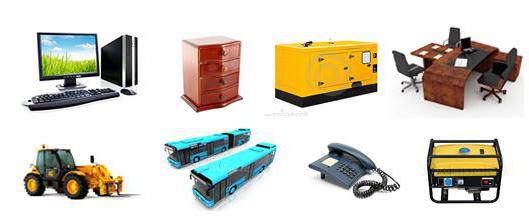Fixed assets in any organization are presented in the form of a certain (active) part of its property. They are used by the enterprise for a long (more than a year) period in the production process and for managerial purposes. Let us further consider what constitute a group of fixed assets of the Russian Federation. 
Asset Acceptance Conditions
Groups of fixed assets are recorded in the documentation if they:
- Designed for use in the creation of products, the provision of services / performance of work, as well as for providing third-party companies for temporary use / ownership for a fee.
- Will not be subsequently resold.
- Able to bring economic profit to the enterprise in the coming periods.
- Designed for operation for a long time (more than 12 months) or for a cycle if it is more than a year.
Asset Accounting Groups
According to current standards, OS include:
- Facilities.
- Equipment and machinery.
- Building.
- Regulating and measuring devices and devices.
- Office equipment and computers.
- Household and industrial equipment, tools.
- Motor vehicles.
- Perennial plants.
- Breeding, working and productive cattle.
- Other types of tangible assets when using which the above conditions are met.
Exceptions
The classifier of groups of fixed assets does not include:
- Items whose service life is less than a year, regardless of their value.
- Fishing gear.
- Items whose value is lower than the limit established by the Ministry of Finance (20 thousand rubles), regardless of their operational period. Exceptions are agricultural machinery, mechanized construction tools, weapons, livestock and livestock. They are included in groups of fixed assets, regardless of their value.
- Alloy cable, delimbers, gas-powered saws, temporary and seasonal branches of roads, temporary shelters in the forest with a period of operation of less than two years.
- Special-purpose appliances and tools, regardless of their price.
- Overalls and shoes, as well as bedding, regardless of the term of operation and the cost of these items.
- The form, which is intended for the issue to employees, shoes and clothes of employees of medical, educational institutions, social services and other budget organizations, regardless of the period of use and price.
- Replaceable equipment, adaptations to the OS, which are repeatedly used in the production cycle and other devices created in specific conditions, regardless of their cost.
- Temporary devices, fixtures, structures, the costs of which are included in the cost of construction and installation work as part of overhead costs.
- A container for storage in warehouses of inventory or for technological operations, the price of which is within the limits established by the Ministry of Finance.
- Items for rental, regardless of their value.
- Perennial plants that are grown in nurseries as planting material.
- Fattening animals and young animals, fur-bearing animals, rabbits, poultry, bee families, guard and sled dogs, experimental animals.
- Equipment and machines included in the category of finished products and located in the warehouses of manufacturing organizations, sales and supply enterprises, delivered for installation or to be installed, listed on the balance of capital construction, located on the way.
Features of application of PBU 6/01
The requirements of the rules apply to the following groups of fixed assets:
- Power and working machines and equipment.
- Building.
- Computing technique.
- Regulating and measuring instruments and devices.
- Transport.
- Instruments.
- Production and household equipment, tools.
- Perennial plantings.
- Productive, working, breeding cattle.
- Capital expenditures on radical land improvements (irrigation, drainage and other land reclamation works).
- Facilities.
- Objects of nature management.
- Land.
- Investments in leased and other OS facilities.
These rules do not apply to:
- Financial and capital investments.
- Items in transit, delivered for installation or to be installed.
- Equipment, machinery and other similar objects that are listed as finished products in warehouses of manufacturing companies and as goods in trade organizations.

Postings
Groups of fixed assets that are intended only for temporary use or possession for a fee or for profit are reflected in the statements in profitable investments in tangible assets on the account. 03. Other operating systems are recorded on the account. 01. Items owned by more than two companies are reflected by each company in accordance with its share in the common property. For the preparation of accounting and tax reporting classification of fixed assets included in depreciation groups. It was approved by Government Decision No. 1 of January 1, 2002.
OS rating
Groups of fixed assets may be carried at replacement, residual and historical cost. The latter represents the amount of the actual expenses of the company for the acquisition, manufacture, construction (construction) of fixed assets, excluding VAT and other reimbursable deductions. Acceptance of fixed assets for accounting is carried out at their initial cost. The valuation of fixed assets contributed to the authorized capital as a contribution is the monetary value agreed by the founders. The initial value of assets that were received free of charge under a gift agreement is presented as the current market price at the time of reflection of the accepted items in the primary documentation. When acquiring fixed assets as a result of the exchange, the value of the transferred values is taken into account in the framework of the concluded agreement. In the event that it is impossible to determine the price, an initial assessment is carried out on similar subjects. In case of revaluation, partial liquidation, modernization, retrofitting, reconstruction, as well as completion, the initial cost is subject to adjustment.
Important point
Some accountants have a question: "Which group of fixed assets should be included in the fixed assets each year in the amount of expenses, regardless of the date of completion?" This category includes capital investments for radical land improvements, as well as perennial plants. The amount of costs relates to the areas taken into operation in the current year. 
Residual and replacement value
Their indicators are also taken into account when reporting. The residual value is the difference between depreciation and historical cost. This value is reflected in the balance sheet. Recovery is called the cost of the OS in modern conditions, with the current technology and prices. This value is used when revaluing assets. In the case of recalculating the value of fixed assets, it should be noted that subsequently such revaluation should be performed regularly.This is necessary so that their new price does not have significant differences from the recovery price.
Limits
Objects whose value is not more than 20 thousand rubles. per unit, can be reflected in the documentation as part of the MPZ. To ensure their safety at the enterprise should be organized proper control of their movement. Operations on these facilities should be filled out with primary documentation for inventory accounting. In particular, f. M-4 and M-17. Objects, the cost of which is up to 40 thousand rubles. on the date of commissioning, are deducted at a time on material costs. If the disposal limit for financial statements exceeds the tax limit, a deferred tax asset is generated.
Classification of fixed assets included in depreciation groups
In each enterprise, in the process of activity, the cost of fixed assets is transferred to manufactured products, rendered services / work performed. This process is called depreciation. Its accrual is carried out monthly. The rules establish that each group of depreciation of fixed assets is calculated separately. Accrual is not made in relation to:
- Productive livestock.
- Objects of external improvement and other similar elements of the road sector.
- Items whose consumer characteristics do not change over time. The classifier of fixed assets by depreciation groups, therefore, does not include museum exhibits and collections, land and others.
- Perennial plantations that have not reached the operational age.
- Housing objects, if they are not used for profit.
- OS, which are used to implement the norm of the legislation on mobilization training, preserved and not participating in the production process, in the provision of services / work, in the management needs of the enterprise or are provided for temporary use / ownership for a fee.
All other property that meets the above requirements is included in the classifier of fixed assets by depreciation groups.
Accrual Features
Each group of depreciation of fixed assets should be calculated starting from the first day of the month that follows the period of the fixed asset commissioning. The accrual is performed over the period during which the useful use of the OS was carried out. Calculation ceases on the first day of the month following the period in which the total cost of fixed assets was written off, or they are excluded from depreciable property. 
Useful life
It should be understood as the period during which the depreciation groups of fixed assets generate income (economic profit). Useful life set by the company independently at the time of acceptance of the assets received The length of the period is recorded in accounting policies. When carrying out technical re-equipment, modernization, reconstruction, the useful life is subject to revision. For the preparation of financial statements, the expected time period for using the fixed asset and its expected physical depreciation on the basis of regulatory and other restrictions on the use of the asset is taken as the specified period. In tax reporting terms are determined by numbers that have depreciation groups of fixed assets. They can also be used for the preparation of accounting documents. In the event that the classifier does not contain an indication of the useful life, it is determined by the company on its own. In this case, the company should proceed from:
- The estimated period of operation of the property taken in accordance with the intensity of its use.
- Predicted physical wear and tear.It will depend on the operating mode (the number of shifts in which the main asset will participate in the production process), the influence of the natural conditions of the enterprise, the negative impact of external factors.

Frequency and quality of repair work and preventive measures will be of no small importance.
